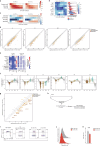Systemic inflammation impairs myelopoiesis and interferon type I responses in humans
- PMID: 40251340
- PMCID: PMC12043512
- DOI: 10.1038/s41590-025-02136-4
Systemic inflammation impairs myelopoiesis and interferon type I responses in humans
Abstract
Systemic inflammatory conditions are classically characterized by an acute hyperinflammatory phase, followed by a late immunosuppressive phase that elevates the susceptibility to secondary infections. Comprehensive mechanistic understanding of these phases is largely lacking. To address this gap, we leveraged a controlled, human in vivo model of lipopolysaccharide (LPS)-induced systemic inflammation encompassing both phases. Single-cell RNA sequencing during the acute hyperinflammatory phase identified an inflammatory CD163+SLC39A8+CALR+ monocyte-like subset (infMono) at 4 h post-LPS administration. The late immunosuppressive phase was characterized by diminished expression of type I interferon (IFN)-responsive genes in monocytes, impaired myelopoiesis and a pronounced attenuation of the immune response on a secondary LPS challenge 1 week after the first. The infMono gene program and impaired myelopoiesis were also detected in patient cohorts with bacterial sepsis and coronavirus disease. IFNβ treatment restored type-I IFN responses and proinflammatory cytokine production and induced monocyte maturation, suggesting a potential treatment option for immunosuppression.
© 2025. The Author(s).
Conflict of interest statement
Competing interests: The authors declare no competing interests.
Figures















References
-
- Vincent, J.-L. et al. Assessment of the worldwide burden of critical illness: the Intensive Care Over Nations (ICON) audit. Lancet Respir. Med.2, 380–386 (2014). - PubMed
-
- Fleischmann, C. et al. Assessment of global incidence and mortality of hospital-treated depsis. Current estimates and limitations. Am. J. Respir. Crit. Care Med.193, 259–272 (2016). - PubMed
MeSH terms
Substances
Grants and funding
LinkOut - more resources
Full Text Sources
Research Materials
Miscellaneous

